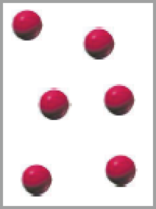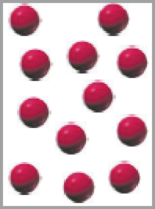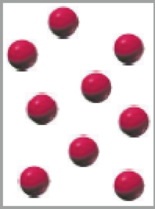
General Chemistry: Atoms First
2nd Edition
ISBN: 9780321809261
Author: John E. McMurry, Robert C. Fay
Publisher: Prentice Hall
expand_more
expand_more
format_list_bulleted
Textbook Question
Chapter 12, Problem 12.25CP
Consider the first-order decomposition of A molecules (red spheres) in three vessels of equal volume.



- (a) What are the relative rates of decomposition in vessels (1)–(3)?
- (b) What are the relative half-lives of the reactions in vessels (1)–(3)?
- (c) How will the rates and half-lives be affected if the volume of each vessel is decreased by a factor of 2?
Expert Solution & Answer
Want to see the full answer?
Check out a sample textbook solution
Students have asked these similar questions
ELECTROCAPILAR EQUATION FOR IDEALLY POLARIZED ELECTRODES.
Briefly state the electrocapillary equation for ideally polarized electrodes.
What is surface excess according to the Gibbs model?
Chapter 12 Solutions
General Chemistry: Atoms First
Ch. 12.1 - The oxidation of iodide ion by arsenic acid,...Ch. 12.1 - Prob. 12.2PCh. 12.2 - Consider the last two reactions in Table 12.2....Ch. 12.3 - The oxidation of iodide ion by hydrogen peroxide...Ch. 12.3 - Prob. 12.5PCh. 12.3 - Prob. 12.6CPCh. 12.4 - Prob. 12.7PCh. 12.4 - Prob. 12.8PCh. 12.5 - Prob. 12.9PCh. 12.5 - Prob. 12.10CP
Ch. 12.6 - Prob. 12.11PCh. 12.6 - Prob. 12.12PCh. 12.6 - Prob. 12.13PCh. 12.6 - Prob. 12.14PCh. 12.7 - Prob. 12.15PCh. 12.9 - Prob. 12.16CPCh. 12.10 - Prob. 12.17PCh. 12.11 - Prob. 12.18PCh. 12.12 - Prob. 12.19PCh. 12.13 - Prob. 12.20PCh. 12.13 - Prob. 12.21PCh. 12.14 - Prob. 12.22CPCh. 12.15 - Prob. 12.23PCh. 12 - The following reaction is first order in A (red...Ch. 12 - Consider the first-order decomposition of A...Ch. 12 - Prob. 12.26CPCh. 12 - The following pictures represent the progress of...Ch. 12 - Prob. 12.28CPCh. 12 - Prob. 12.29CPCh. 12 - The relative rates of the reaction A + B AB in...Ch. 12 - Prob. 12.31CPCh. 12 - Prob. 12.32CPCh. 12 - Prob. 12.33CPCh. 12 - Prob. 12.34SPCh. 12 - Prob. 12.35SPCh. 12 - Prob. 12.36SPCh. 12 - Prob. 12.37SPCh. 12 - Prob. 12.38SPCh. 12 - Prob. 12.39SPCh. 12 - Prob. 12.40SPCh. 12 - The oxidation of 2-butanone (CH3COC2H5) by the...Ch. 12 - Prob. 12.42SPCh. 12 - The reaction 2 NO(g) + 2 H2(g) N2(g) + 2 H2O(g)...Ch. 12 - Bromomethane is converted to methanol in an...Ch. 12 - The oxidation of Br by BRO3, in acidic solution is...Ch. 12 - Prob. 12.46SPCh. 12 - Prob. 12.47SPCh. 12 - Prob. 12.48SPCh. 12 - Prob. 12.49SPCh. 12 - The initial rates listed in the following table...Ch. 12 - Prob. 12.51SPCh. 12 - Prob. 12.52SPCh. 12 - The rearrangement of methyl isonitrile (CH3NC) to...Ch. 12 - Prob. 12.54SPCh. 12 - What is the half-life (in hours) of the reaction...Ch. 12 - Prob. 12.56SPCh. 12 - Prob. 12.57SPCh. 12 - Prob. 12.58SPCh. 12 - What is the half-life (in days) of the reaction in...Ch. 12 - Prob. 12.60SPCh. 12 - Prob. 12.61SPCh. 12 - Prob. 12.62SPCh. 12 - Prob. 12.63SPCh. 12 - Prob. 12.64SPCh. 12 - Prob. 12.65SPCh. 12 - Prob. 12.66SPCh. 12 - Prob. 12.67SPCh. 12 - Prob. 12.68SPCh. 12 - Prob. 12.69SPCh. 12 - Prob. 12.70SPCh. 12 - Prob. 12.71SPCh. 12 - Prob. 12.72SPCh. 12 - Prob. 12.73SPCh. 12 - Prob. 12.74SPCh. 12 - Prob. 12.75SPCh. 12 - Prob. 12.76SPCh. 12 - Prob. 12.77SPCh. 12 - Prob. 12.78SPCh. 12 - Prob. 12.79SPCh. 12 - Rate constants for the reaction NO2(g) + CO(g) ...Ch. 12 - Prob. 12.81SPCh. 12 - Prob. 12.82SPCh. 12 - Prob. 12.83SPCh. 12 - Prob. 12.84SPCh. 12 - Prob. 12.85SPCh. 12 - Prob. 12.86SPCh. 12 - Prob. 12.87SPCh. 12 - Prob. 12.88SPCh. 12 - Prob. 12.89SPCh. 12 - Prob. 12.90SPCh. 12 - Prob. 12.91SPCh. 12 - Prob. 12.92SPCh. 12 - Prob. 12.93SPCh. 12 - The reaction 2 NO2(g) + F2(g) 2 NO2F(g) has a...Ch. 12 - Prob. 12.95SPCh. 12 - Prob. 12.96SPCh. 12 - Prob. 12.97SPCh. 12 - Prob. 12.98SPCh. 12 - Prob. 12.99SPCh. 12 - Prob. 12.100SPCh. 12 - Sulfur dioxide is oxidized to sulfur trioxide in...Ch. 12 - Consider the following mechanism for the...Ch. 12 - Prob. 12.103SPCh. 12 - Prob. 12.104CHPCh. 12 - Prob. 12.105CHPCh. 12 - Prob. 12.106CHPCh. 12 - Consider three reactions with different values of...Ch. 12 - Prob. 12.108CHPCh. 12 - Prob. 12.109CHPCh. 12 - Prob. 12.110CHPCh. 12 - When the temperature of a gas is raised by 10 C,...Ch. 12 - Prob. 12.112CHPCh. 12 - Prob. 12.113CHPCh. 12 - Prob. 12.114CHPCh. 12 - Prob. 12.115CHPCh. 12 - Prob. 12.116CHPCh. 12 - Prob. 12.117CHPCh. 12 - Prob. 12.118CHPCh. 12 - Consider the following concentrationtime data for...Ch. 12 - Prob. 12.120CHPCh. 12 - Prob. 12.121CHPCh. 12 - Prob. 12.122CHPCh. 12 - Prob. 12.123CHPCh. 12 - Assume that you are studying the first-order...Ch. 12 - Prob. 12.125CHPCh. 12 - Prob. 12.126CHPCh. 12 - Prob. 12.127CHPCh. 12 - Prob. 12.128CHPCh. 12 - Use the following initial rate data to determine...Ch. 12 - Prob. 12.130CHPCh. 12 - The following experimental data were obtained in a...Ch. 12 - Prob. 12.132CHPCh. 12 - Prob. 12.133CHPCh. 12 - Prob. 12.134CHPCh. 12 - Prob. 12.135CHPCh. 12 - Polytetrafluoroethylene (Teflon) decomposes when...Ch. 12 - Values of Ea = 6.3 kJ/mol and A = 6.0 108 M1 s1...Ch. 12 - Prob. 12.138MPCh. 12 - The rate constant for the decomposition of gaseous...Ch. 12 - Prob. 12.140MPCh. 12 - Prob. 12.141MPCh. 12 - Prob. 12.142MPCh. 12 - Prob. 12.143MP
Knowledge Booster
Learn more about
Need a deep-dive on the concept behind this application? Look no further. Learn more about this topic, chemistry and related others by exploring similar questions and additional content below.Similar questions
- Using Benzene as starting materid show how each of the Following molecules Contel Ve syntheswed CHI 9. b -50311 с CHY 503H Ночто d. อ •NOV e 11-0-650 NO2arrow_forwardThe molecule PYRIDINE, 6th electrons and is therefore aromatre and is Assigned the Following structure contering Since aromatk moleculoy undergo electrophilic anomatic substitution, Pyridine shodd undergo The Following reaction + HNO3 12504 a. write all of the possible Mononitration Products that could Result From this reaction 18. Bared upon the reaction mechanison determime which of these producty would be the major Product of the hegetionarrow_forwarda. Explain Why electron withdrawing groups tend to be meta-Directors. Your answer Should lyclude all apropriate. Resonance contributing Structures fo. Explain why -ll is an outho -tura drccton even though chlorine has a very High Electronegativityarrow_forward
- 9. Write Me product as well as the reaction Mechanism For each of the Following Vanctions +H₂504 4.50+ T C. +212 Fellz 237 b. Praw the potential energy Diagrams For each OF Mese Rauctions and account For any differences that appear in the two potential Puergy Diagrams which of here two reactions 19 Found to be Reversable, Rationalice your answer based upon the venation mechanisms and the potential energy diagrams.arrow_forward9. Write Me product as well as the reaction Mechanism For each of the Following Veritious +H2504 4.50+ + 1/₂ Felly ◎+ 7 b. Praw he potential energy Diagrams For each OF Mese Ronctions and account for any differences that appeak in the two potential Puergy Diagramsarrow_forwardDraw the major product of this reaction. Ignore inorganic byproducts. Incorrect, 3 attempts remaining 1. excess Br2, NaOH 2. neutralizing workup Qarrow_forward
- Given the electrode Pt | Ag | Ag+ (aq), describe it.arrow_forwardAt 25°C, the reaction Zn2+ + 2e ⇄ Zn has a normal equilibrium potential versus the saturated calomel electrode of -1.0048 V. Determine the normal equilibrium potential of Zn versus the hydrogen electrode.Data: The calomel electrode potential is E° = 0.2420 V versus the normal hydrogen electrode.arrow_forwardElectrochemistry. State the difference between E and E0.arrow_forward
- In an electrolytic cell, the positive pole is always assumed to be on the right side of the battery notation. Is that correct?arrow_forwardIn an electrolytic cell, the positive pole is always assumed to be on the right side of the battery. Is that correct?arrow_forwardCalculate the free energy of formation of 1 mol of Cu in cells where the electrolyte is 1 mol dm-3 Cu2+ in sulfate solution, pH 0. E° for the Cu2+/Cu pair in this medium is +142 mV versus ENH.Assume the anodic reaction is oxygen evolution.Data: EH2 = -0.059 pH (V) and EO2 = 1.230 - 0.059 pH (V); 2.3RT/F = 0.059 Varrow_forward
arrow_back_ios
SEE MORE QUESTIONS
arrow_forward_ios
Recommended textbooks for you
 Chemistry & Chemical ReactivityChemistryISBN:9781337399074Author:John C. Kotz, Paul M. Treichel, John Townsend, David TreichelPublisher:Cengage Learning
Chemistry & Chemical ReactivityChemistryISBN:9781337399074Author:John C. Kotz, Paul M. Treichel, John Townsend, David TreichelPublisher:Cengage Learning Chemistry: Principles and PracticeChemistryISBN:9780534420123Author:Daniel L. Reger, Scott R. Goode, David W. Ball, Edward MercerPublisher:Cengage Learning
Chemistry: Principles and PracticeChemistryISBN:9780534420123Author:Daniel L. Reger, Scott R. Goode, David W. Ball, Edward MercerPublisher:Cengage Learning Chemistry: Principles and ReactionsChemistryISBN:9781305079373Author:William L. Masterton, Cecile N. HurleyPublisher:Cengage Learning
Chemistry: Principles and ReactionsChemistryISBN:9781305079373Author:William L. Masterton, Cecile N. HurleyPublisher:Cengage Learning ChemistryChemistryISBN:9781305957404Author:Steven S. Zumdahl, Susan A. Zumdahl, Donald J. DeCostePublisher:Cengage Learning
ChemistryChemistryISBN:9781305957404Author:Steven S. Zumdahl, Susan A. Zumdahl, Donald J. DeCostePublisher:Cengage Learning Chemistry: An Atoms First ApproachChemistryISBN:9781305079243Author:Steven S. Zumdahl, Susan A. ZumdahlPublisher:Cengage Learning
Chemistry: An Atoms First ApproachChemistryISBN:9781305079243Author:Steven S. Zumdahl, Susan A. ZumdahlPublisher:Cengage Learning

Chemistry & Chemical Reactivity
Chemistry
ISBN:9781337399074
Author:John C. Kotz, Paul M. Treichel, John Townsend, David Treichel
Publisher:Cengage Learning

Chemistry: Principles and Practice
Chemistry
ISBN:9780534420123
Author:Daniel L. Reger, Scott R. Goode, David W. Ball, Edward Mercer
Publisher:Cengage Learning

Chemistry: Principles and Reactions
Chemistry
ISBN:9781305079373
Author:William L. Masterton, Cecile N. Hurley
Publisher:Cengage Learning

Chemistry
Chemistry
ISBN:9781305957404
Author:Steven S. Zumdahl, Susan A. Zumdahl, Donald J. DeCoste
Publisher:Cengage Learning

Chemistry: An Atoms First Approach
Chemistry
ISBN:9781305079243
Author:Steven S. Zumdahl, Susan A. Zumdahl
Publisher:Cengage Learning

Kinetics: Initial Rates and Integrated Rate Laws; Author: Professor Dave Explains;https://www.youtube.com/watch?v=wYqQCojggyM;License: Standard YouTube License, CC-BY